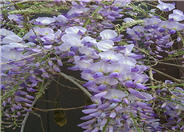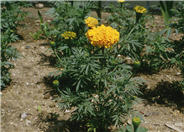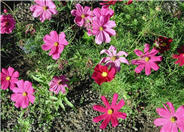
Common name:Chinese Wisteria
Botanical name:Wisteria sinensis
While the sinensis is similar to the floribunda, it bears more rounded, full clusters of strongly fragrant flowers which open more or less, all at once. There are usually 13-15 leaflets per leaf, and they require full sun and average to little watering. It comes in many colors in the blues, whites and purples.-Monterey Bay Nursery

Common name:American or African Marigold
Botanical name:Tagetes erecta
This Marigold will grow to about 3' high and has small, green or dark green leaves with orange, yellow, or white flowers that bloom in spring, summer, and fall.

Common name:Cosmos
Botanical name:Cosmos bipinnatus
Cosmos bipinnatus is an annual. It grows up to 8' high and 1.5'-2.5' wide. Blossoms are 3'-4' wide, with tufted yellow centers and rays in white or shades of pink, rose, lavender, purple, or crimson.

Common name:Commom Yarrow
Botanical name:Achillea millefolium
This Achillea features spreading mats of fern-like rosettes, along with deeply divided leaves of a green or gray green color. In this form, the flowers are usually a white tone. Stems can reach 2'-3' above foliage. Yarrows propagate easily from rooted cuttings or division, which should be performed in the early spring or fall. Following bloom, one should dead head the plant and divide the clumps when it appears crowded.

Common name:Australian Willow, Wilga
Botanical name:Geijera parviflora
This evergreen tree reaches a height of 25', with 3"-6" long, medium length, green colored leaves that are narrow. Its main branches sweep up and out, while the smaller branches tend to hang down.

Common name:California Pepper, Mission Pepper
Botanical name:Schinus molle
The California Pepper is a fast growing evergreen tree that will mature to a height of 25'-40' and as wide. Its bright green leaves are divided into many narrow, 1.5"-2" long leaflets.
| Designer: Homeowner | Portal to Country Living |
Photographer: GardenSoft |
Soils and Compost:
Incorporate compost 6" into your soil to retain water, reduce compaction, feed earthworms, and provide valuable nutrients to your plants.
Water Saving Tip:
In general, lawns only need to be watered once every three days.
Check your irrigation controller and reduce watering times if necessary.
Integrated Pest Management:
Attract, or buy beneficial insects such as ladybugs and lacewings to control pest outbreaks in your garden.

